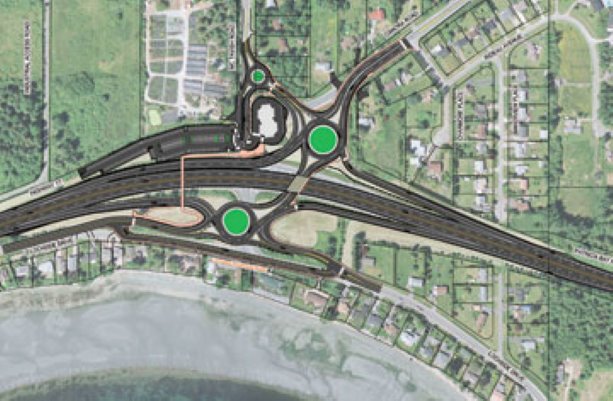After years of lobbying, a major interchange, complete with two large roundabouts, is being constructed to improve access at Victoria International Airport.
Roadbuilidng
After years of lobbying, a major interchange, complete with two large roundabouts, is being constructed to improve access at Victoria International Airport.
Fast-moving traffic heading to the airport from Victoria on the busy Pat Bay Highway has for years, accessed the airport by making a left-hand turn onto McTavish Road.
At times, the turning lane would exceed its capacity, forcing vehicles to wait in the left passing lane, a dangerous situation, said Richard Paquette, Victoria International Airport’s CEO.
After leaving the airport, vehicles, including big tour buses, were forced to turn left onto McTavish at an uncontrolled intersection, again making for risky travel.
The $24-million project, which broke ground in late November, will feature two large, and one small, roundabouts, interchange overpass, pedestrian overpass, new roads and major expansion of transit facilities, including a much-expanded park-and-ride.
The Pat Bay Highway (also known as Highway 170 will get 1.02 km of upgrades and 1.8 km of new highway ramps.
Local roads, including McTavish, will see 1.5 km of reconstructed and new roads.
“This project is high on the list of what we want to see,” Paquette said.
Another of the many projects being funded by the $4-billion federal Infrastructure Stimulus Fund, the federal $10.5-million contribution comes with the condition that the interchange must be finished by March 2011.
The B.C. government also kicked in $10.5 million and the Victoria Airport Authority contributed $3 million, those funds coming from the airport’s improvement fee fund.
As with other Infrastructure Stimulus Projects, work schedules have been condensed to meet tight deadlines.
While the largest contract for the major interchange work won’t be awarded until March, a handful of companies have started preliminary work.
In July, Richmond-based Urban Systems began designing, what design manager Rod Friesen described as an innovative project.
The two large roundabouts planned for each side of the Pat Bay Highway will be a rare sight, he said.
Common in the U.K., Australia and parts of the U.S., he was aware of only a couple of large roundabouts in Canada.
But there’s going to be more of the circular byways.
The province has said its first preference for intersection control is now roundabouts, Paquette said.
And there are compelling reasons why.
Vehicles travel at a slower speed through a roundabout and when there’s a collision, contact is often a glancing blow, not a potentially deadly T-bone event.
Another benefit is that the expense associated with traffic lights is removed because there are no controlled intersections.
For the last couple years, a small roundabout on the way to the airport replaced what was a dangerous intersection.
Since the installation, there have been no crashes, Paquette said.
In addition to designing the roundabout, Urban Systems is drafting bridge, utility, landscape and drainage plans, with tenders for work going out in mid-February, Friesen said.
The biggest challenge is the time constraint.
This is why wick drains are being installed by Edmonton-based Nilex to speed up consolidation of the soil where the interchange overpass will be built.
The soft, underlying clay soil requires pre-loaded fill.
Without wick drains, it could take up to five years for consolidation of that soil, said Brad Zaworksi, a Nilex project manager.
Instead, 6,000 vertical wick drains will be placed about every 1.5 metres in a 60,000-metre lineal space, cutting consolidation time to four to six months, Zaworski said.
The contract is worth $330,000 and is to be complete by the end of February, he said.
Four Nilex employees from the Victoria area, including one worker who came out of retirement, will be on site.
The drains will be installed to about a 10-metre depth by inserting a tubular steel mandrel containing the wick, into the ground using static force.
When the mandrel sleeve is withdrawn, the wick drain is anchored at the desired depth by a specially designed anchor plate.
However, a challenge has surfaced.
A hard layer of soil near the surface requires pre-augering.
At 60,000 lineal metres, Nilex’s McTavish project is relatively small.
Large projects, when Nilex installs wick drains over 800,000 to two million lineal metres, are common.
While the McTavish project has forced travellers to find alternate routes, the abbreviated completion date won’t prolong the inconvenience, Paquette said
“Sometimes projects like this carry on longer than they should,” he said.











Recent Comments
comments for this post are closed